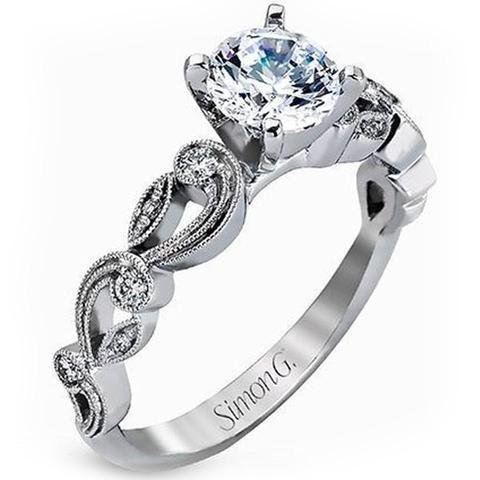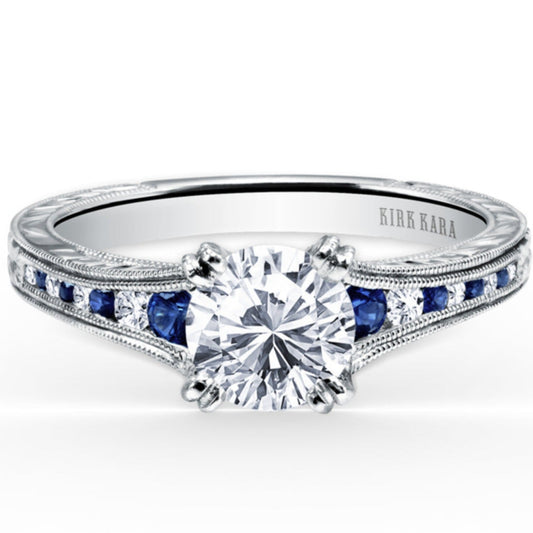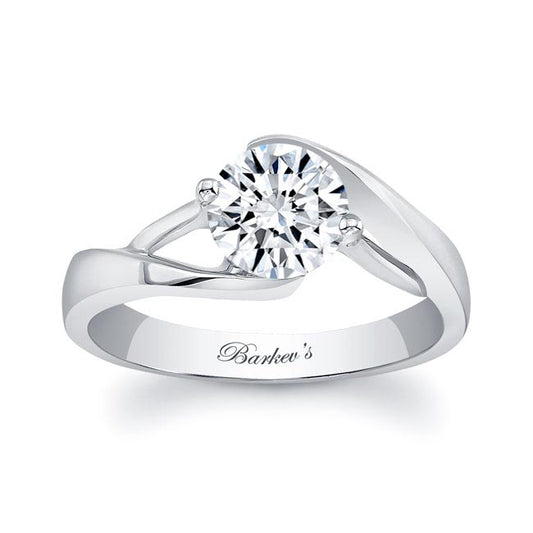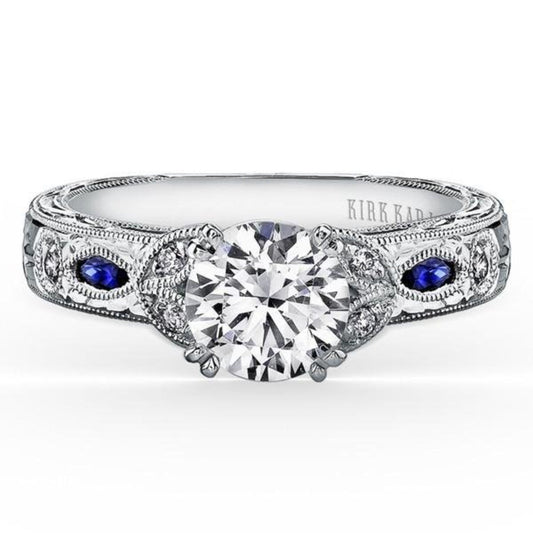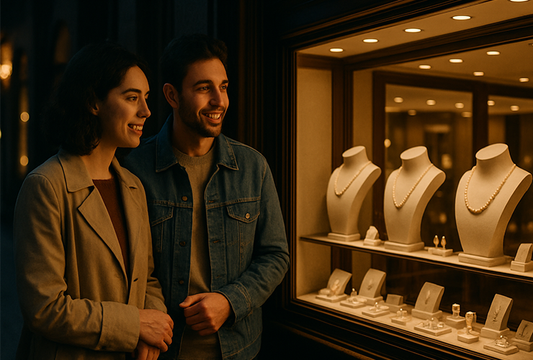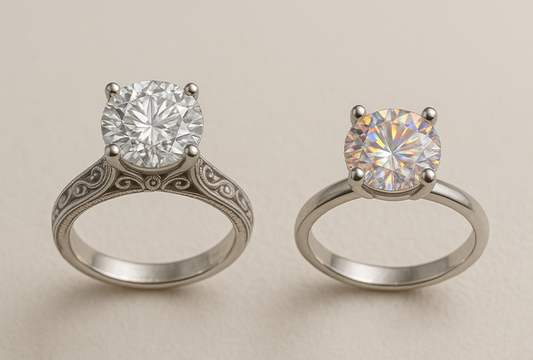Moissanite - the popular diamond alternative, is taking the world by storm.
But there’s still a lot of confusion around lab diamonds and Moissanite.
Are they both diamonds?
Do they look the same and cost the same?
Who should buy which, and what are the differences?
We will break down the facts about lab diamonds and Moissanite, so you know the difference and which one might best suit you!
We’ll also suggest some other diamond alternatives later in the blog.
Let’s get to it!
In this article...
What Is a Lab Diamond?
A lab diamond, also known as a cultured diamond, a synthetic diamond, or a man-made diamond, is a diamond that is created in a laboratory setting using advanced technology.
Lab diamonds are made using one of two methods: High-Pressure High Temperature (HPHT) or Chemical Vapor Deposition (CVD).
Both methods aim to replicate the conditions under which natural diamonds form, but they happen faster and in a controlled environment.
Lab diamonds are physically and chemically identical to natural diamonds and can be used like natural diamonds.
They are graded using the same criteria as natural diamonds and can be cut, polished, and set in jewelry.

They also have similar optical, thermal, and electrical properties as natural diamonds. In other words, they are still considered real diamonds - hurray!
The main difference between a lab diamond and a natural diamond is how they are formed.
Natural diamonds are formed deep within the earth’s crust over millions of years, while lab diamonds are created in a controlled environment in a matter of weeks or months.
As a result, lab diamonds are less expensive than natural diamonds.
They can be a good option for people who want a diamond but are looking for a more affordable and sustainable option.
They are also a good option for those who have ethical concerns about the mining of natural diamonds.
Is Moissanite a Lab Diamond?
No, Moissanite is not a lab diamond.
While both lab diamonds and Moissanite are created in a laboratory setting, they are made of different materials and have different properties.
Moissanite is a mineral made of silicon carbide, and it’s not a diamond. Moissanite was first discovered in a meteorite crater, which is incredibly cool but is also lab-grown today.
While it has similar properties to a diamond, such as a high refractive index and brilliance, it does not have the same chemical composition and physical properties.
The take away - Moissanite is a lab-grown gemstone, but it is not a lab diamond.
It is a separate, distinct mineral that has unique properties and characteristics.
What is Moissanite?
While not a diamond or lab diamond, Moissanite is still a fascinating gemstone!
Moissanite is a naturally occurring mineral made of silicon carbide (SiC) that was first discovered in a meteorite crater in Arizona, USA, by a French scientist named Henri Moissan in 1893.
It is a rare mineral that is typically found in tiny quantities in nature. And, of course, Henri thought it was a great idea to name the mineral after its founder!
Today, most of the Moissanite used in rings is lab-grown, meaning it’s created in a controlled environment in a laboratory.
The process of creating lab-grown Moissanite involves replicating the high-pressure, high-temperature conditions that occur in nature to grow the crystals.
Moissanite is used as a diamond simulant because it has a similar appearance and some similar properties to diamonds, such as a high refractive index, and brilliance.
However, Moissanite is less expensive than diamond and has a different chemical composition and physical properties. For example, it has a hardness of 9.25 on the Mohs scale, which is slightly less than a diamond with a score of 10.
Moissanite has become a popular choice among customers looking for a more sustainable and ethical option than diamond, as it does not require mining and has a lower carbon footprint.
You should note that while Moissanite can closely mimic the appearance of a diamond, it can be distinguished from a diamond by a professional gemologist using specialized equipment.
The Key Differences Between Lab-Grown & Moissanite
Sparkle
Both lab-grown diamonds and Moissanite have a high refractive index, which means they both have a lot of sparkle and fire.
However, Moissanite have a higher refractive index than lab-grown diamonds, which means that Moissanite will have more sparkle and fire.
Cost
Lab-grown diamonds are generally more expensive than Moissanite because they are still real diamonds.
The cost of lab-grown diamonds can vary depending on factors such as carat weight, cut, color, and clarity, but they are generally more expensive than Moissanite.
Hardness
As we highlighted above, lab-grown diamonds, like their natural counterparts, are the hardest naturally occurring minerals with a Mohs hardness of 10. On the other hand, Moissanite has a hardness of 9.25 on the Mohs scale.
This means that lab-grown diamonds are more durable and less likely to get scratched or damaged than Moissanite.
Featured Affordable Moissanite Engagement Rings
Simon G. Vintage Style Scrollwork Filigree Diamond Engagement Ring
Artcarved "Peyton" Diamond Engagement Ring Featuring Scrollwork Design
Kirk Kara "Stella" Blue Sapphire Channel Set Diamond Engagement Ring
Barkev's Swirl Compass Set Princess Diamond Engagement Ring
Barkev's Swirl Solitaire Diamond Engagement Ring
Kirk Kara "Dahlia" Marquise Shaped Blue Sapphire Diamond Engagement Ring
Simon G. Vintage Style Bezel Set Side Diamond Engagement Ring
Barkev's Double Row Shared Prong Set Diamond Engagement Ring
The benefit of both Moissanite and lab-grown diamonds is that they are good options for those who want a beautiful and durable gemstone but are looking for a more affordable option than a natural diamond!
Which Is Better - Moissanite or Lab-Grown Diamond?
Moissanite and lab-grown diamonds are popular choices for people who want a beautiful and durable gemstone with similar properties to a diamond but without the price tag!
Both are also sustainable and ethical, so it comes down to preference.
Some other factors that may help you choose between Moissanite and lab-grown diamonds include:
Costs
Moissanite is less expensive than diamond, making it a more affordable option for those on a budget. Lab diamonds are a great way to own real diamonds without the extra cost of natural diamonds.
Durability
Moissanite is very durable, with a hardness of 9.25 on the Mohs scale, making it resistant to scratches and chipping. Lab diamonds are the most durable, so if you are likely to knock or scratch your gemstone, lab diamonds will hold up best over time!
Ethical Considerations
Moissanite is lab-grown, therefore, doesn’t require mining, and has a lower carbon footprint than natural diamonds. But then, so do lab-grown diamonds, so you get to own a real diamond without any concerns about how it was sourced or mined.
Sparkle
Moissanite has a very high refractive index, which means it has a touch more sparkle and fire than lab-grown diamonds, however lab-grown diamonds still have a lot of sparkle and fire!
Versatility
Moissanite can come in different colors and be cut in different shapes, providing various options for people looking for a specific style.
However, with lab diamonds, you can get a colored diamond at a fraction of the cost of a naturally occurring one, as natural-colored diamonds are incredibly rare!
Who Should Pick Moissanite?
Moissanite is the perfect gemstone for people who dare to be different and want to be trendsetters.
Moissanite has gained popularity over the years, but still has a long way to catch up with diamonds. Yet it is still a stunning mineral that showcases its beauty almost identically to diamonds!
It is an affordable option for those that are shopping on a budget, and its ethical creation means that if you’re looking to do good for the planet, then Moissanite will check all your boxes.
Who Should Pick Lab-Grown Diamonds?
Lab-grown diamonds are for anyone who wants to pay less for a real diamond but still wants the luxury and sparkle of owning diamonds.
They are for those who are environmentally conscious and who may wish to have a more positive impact on the planet!
What Other Diamond Alternatives Are There?
White Sapphire
Sapphire’s come in many different colors, however, white sapphire is a variety of sapphire that is colorless and best mimics the look of a real diamond.
It is a type of corundum, which is a mineral made up of aluminum oxide. White sapphires are often used as a less expensive alternative to diamonds in jewelry, as they have a similar appearance and durability.
They can also be treated with heat or other processes to enhance color and clarity. White sapphires are found in many locations worldwide, including Sri Lanka, Madagascar, and the United States.
Cubic Zirconia (CZ)
Cubic Zirconia is a man-made gemstone made of zirconium oxide.
It is often used as a diamond simulant, which means it is made to look like a diamond but at a much lower cost. CZ is colorless, hard, and optically flawless, making it a popular choice for use in jewelry.
Cubic zirconia is also created in a lab. It is available in a variety of colors, such as pink, blue, yellow, and red, which can be achieved through different methods of color treatment.
Swarovski Zirconia
Swarovski Zirconia is a brand of cubic zirconia (CZ) known for its high quality and brilliance. It is created using a precision-cut method that gives it a diamond-like sparkle and fire.
The Swarovski Zirconia is also available in a wide range of colors and cuts, which can be used to create various jewelry designs.
The Swarovski Zirconia is closely monitored and inspected through the production process to ensure that it meets the brand’s high standards for quality and consistency.
Sharing The Love
So there we have it. Lab-grown diamonds and Moissanite are not the same but share many similar qualities.
Ultimately, if you’re looking for something with a lot of sparkles and an affordable price tag that isn’t harsh on the environment, lab-grown diamonds and Moissanite will be the perfect choices!
And if you’re still undecided, why don’t you visit the Ben Garelick showroom to see lab-grown diamonds and Moissanite up close?
Or, if you don’t live nearby, chat with us online where you can see 360-degree videos of diamonds online.
Our sparkle consultants can also suggest gemstones and send you sparkle videos for your review!
Whatever your preference, you’ll surely find a gemstone you’ll fall in love with!
Visit us at our Buffalo, NY store today. Not nearby? Not to worry - chat with our diamond experts online 24/7, call us on (716) 631-1584, or text (716) 574-0966. Let's find the gemstone that’ll make you shine!

Peter Manka Jr. - Owner at Ben Garelick
Peter Manka Jr. is a passionate member of the family business who joined Ben Garelick in the early 2000s after working in product licensing for Sesame Workshop & The Jim Henson Company for many years. He obtained a degree in diamonds and jewelry from the prestigious Gemological Institute of America (GIA) in order to sharpen his jewelry skills. He takes great pride in providing exceptional customer service and helping clients find the perfect piece of jewelry.
